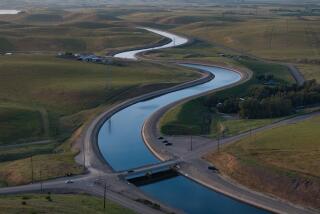Protective Watering for Crops Taxes Reservoirs : Agriculture: Officials say the additional draw to protect against the cold will not have a major impact on future deliveries.
- Share via
Ventura County growers who watered fields to protect crops from the worst freeze in 50 years used 15% to 20% more water than normal, drawing down supplies already critically low from five years of drought, officials said Monday.
Most water district representatives said the additional draw, which will amount to many millions of gallons, would not substantially affect future water deliveries.
However, because the dry cold fronts of the last 10 days brought no rain to the county or to Northern California reservoirs that supply the area’s largest water delivery company, the frost added to predictions of doom for the year ahead.
“Every day we go without rain makes it worse,” said Jim Hubert, general manager of Calleguas Municipal Water District, which provides tap water for about 450,000 eastern county residents. “The frost just complicates matters.”
While frost is an unwelcome complication for water districts, it is part of the annual cycle for which districts plan, said John Johnson, Casitas Municipal Water District general manager.
Johnson estimated that water used for frost protection drew a maximum of 27 acre-feet, or about 9 million gallons, from the Casitas Lake reservoir. The reservoir still contains 130,000 acre-feet, or a three- to four-year supply for the 65,000 people and farms it serves in the Ojai Valley and the western portion of the city of Ventura.
“We would prefer the temperature to be warmer so nobody has to use the water because we are concerned about the long range,” Johnson said. “But for the short term, I didn’t see any significant problems.”
Water figures for the entire county were not available.
Total crop losses in Ventura County are estimated at $100 million for the four-night deep freeze that began Dec. 21 and the milder frost of last weekend, Deputy Agriculture Commissioner David Buettner said.
Buettner said that figure does not include the losses that avocado and citrus growers will suffer in later growing years from lost production due to frost-damaged trees.
“Some citrus and avocado crops in the Ojai and Santa Paula areas were burned back badly enough that it will reduce next year’s crops, but we haven’t yet assessed how much physical damage was done to the trees,” he said.
Orchards in those areas endured temperatures that fell to 15 degrees, the coldest and most damaging since the freeze of 1937, National Weather Service meteorologist Terry Schaeffer said. The Oxnard Plain, where must of the county’s vegetables and row crops are grown, escaped much of the damaging cold, he said.
Temperatures this week are expected to remain above the critical 28-degree mark at which crop damage occurs, with light and dry wind from the east. But even lower temperatures will not hurt many of the growers who lost most of their citrus or avocado crops.
“You have to get to the low 20s or teens to kill the trees, and that’s not possible in the near future,” Schaeffer said. Rain is not forecast in the near future, but changing weather patterns are opening the possibility of storms from the west by next week, he said.
That change would be more than welcome, said Hubert, whose district is preparing to pass along cutbacks announced Dec. 11 by its supplier, the Metropolitan Water District of Southern California. Metropolitan’s board of directors will decide Jan. 8 whether to further reduce water supplies to member districts, Hubert said.
“With no rain, we’re just going to have to make cutbacks,” Hubert said. “We can’t go on this way.”
Metropolitan announced 5% cutbacks to its municipal water users and 20% reductions for farmers beginning Feb. 1. But if the state receives no rain during the next week, the district board will probably opt for another 5% cutback for cities and another 10% for growers in March or possibly as early as February, spokesman Bob Gomperz said.
If more cutbacks are warranted, the district will reduce supplies by 15% for urban users and by 40% for growers. The final stage of its plan to battle the drought calls for 20% reductions to cities and a 50% reduction for crops.
Some vegetable growers in the Camrosa Water District, which receives most of its water from Calleguas, may suffer cutbacks so severe that they have to reduce the acreage they plant, said Gina Manchester, general manager.
Camrosa, which serves 150 farmers and 25,000 people in eastern Camarillo and the Santa Rosa Valley, already plans a rationing program beginning in February that will penalize growers for using more than an allocated amount of water. But Manchester said Monday that the district may set priorities for water allocations based on the kind of crops.
Manchester said some growers may have to reduce the number of plantings each year or reduce the number of acres they cultivate.
“It’s a very uncertain time for everyone right now,” she said.
More to Read
Sign up for Essential California
The most important California stories and recommendations in your inbox every morning.
You may occasionally receive promotional content from the Los Angeles Times.













